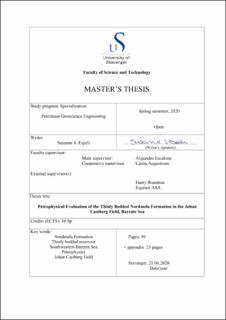| dc.contributor.advisor | Escalona, Alejandro | |
| dc.contributor.advisor | Brandsen, Harry | |
| dc.contributor.advisor | Augustsson, Carita | |
| dc.contributor.author | Espeli, Susanne | |
| dc.coverage.spatial | Southwestern Barents Sea | en_US |
| dc.date.accessioned | 2021-07-07T13:01:05Z | |
| dc.date.available | 2021-07-07T13:01:05Z | |
| dc.date.issued | 2020-07 | |
| dc.identifier.uri | https://hdl.handle.net/11250/2763797 | |
| dc.description | Master's thesis in Petroleum Geosciences Engineering | en_US |
| dc.description.abstract | This study demonstrates how contrasting different distributions of shale in a reservoir determines the petrophysical properties. The Skrugard prospect (Well 7220/8-1), drilled in 2011, confirmed that the western Barents Sea was not only gas prone as the well struck oil and gas in the Stø and Nordmela formations. The field development plan was approved in 2018, with planned production start in late 2022. The new discovery of both oil and gas in the southwestern Barents Sea initiated several studies based on the data from two exploration wells (7220/8-1 and 7220/7-1). The Jurassic Nordmela Formation is a tide dominated formation alternating between sandstone and shale. Commonly thin shale laminae in a reservoir results in underestimation of bulk fraction hydrocarbon using conventional water saturation models such as Archie (1942). Therefore, several other methods such as Waxman and Smits (1968), Thomas and Stieber (1975) and the series receptivity model after Klein and Martin (1997) was addressed to attack this problem.
The study aims to develop a porosity-, water saturation- and permeability model that may contribute to optimize future production from the reservoir in the Nordmela Formation at the Johan Castberg Field, using three main steps: (1) Input – core data measurements will be collected and evaluated together with quality control of the well log data; (2) Petrophysical evaluation – petrophysical model(s) will be generated based on available input data; (3) Correlation, where the resultant petrophysical model(s) will be correlated with the results obtained from core measurements.
The method after Thomas and Stieber (1975) is revised and improved. Results obtained from the newly and confident series resistivity model after Klein and Martin (1997) supports that trustworthy water saturation and net-to-gross calculations can be obtained from the method after Thomas and Stieber (1975) where only gamma ray and density logs are needed. Furthermore, this method differentiate between dispersed and laminated shale which can be used to improve the permeability model and the understanding of differentiation in reservoir quality in a convincing manner. | en_US |
| dc.language.iso | eng | en_US |
| dc.publisher | University of Stavanger, Norway | en_US |
| dc.relation.ispartofseries | Masteroppgave/UIS-TN-IER/2020; | |
| dc.rights | Attribution-NonCommercial-NoDerivatives 4.0 Internasjonal | * |
| dc.rights.uri | http://creativecommons.org/licenses/by-nc-nd/4.0/deed.no | * |
| dc.subject | petroleumsgeologi | en_US |
| dc.subject | Nordmela Formation | en_US |
| dc.subject | Southwestern Barents Sea | en_US |
| dc.subject | Johan Castberg Field | en_US |
| dc.subject | thinly bedded reservoir | en_US |
| dc.subject | petrophysics | en_US |
| dc.subject | petrofysikk | en_US |
| dc.title | Petrophysical Evaluation of the Thinly Bedded Nordmela Formation in the Johan Castberg Field, Barents Sea | en_US |
| dc.type | Master thesis | en_US |
| dc.subject.nsi | VDP::Teknologi: 500::Berg‑ og petroleumsfag: 510::Geoteknikk: 513 | en_US |
| dc.subject.nsi | VDP::Matematikk og Naturvitenskap: 400::Geofag: 450::Petroleumsgeologi og -geofysikk: 464 | en_US |

